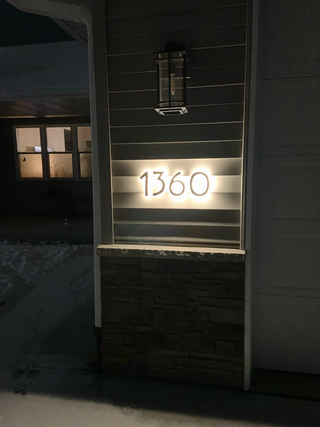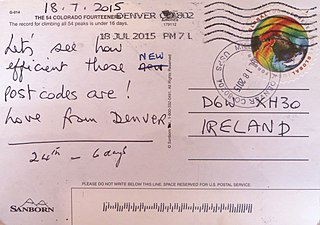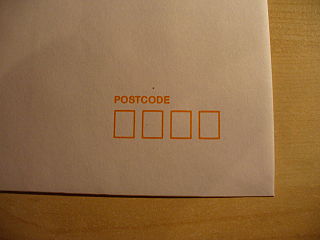Related Research Articles

A postal code is a series of letters or digits or both, sometimes including spaces or punctuation, included in a postal address for the purpose of sorting mail.

Postal codes used in the United Kingdom, British Overseas Territories and Crown dependencies are known as postcodes. They are alphanumeric and were adopted nationally between 11 October 1959 and 1974, having been devised by the General Post Office. A full postcode is known as a "postcode unit" and designates an area with several addresses or a single major delivery point.

The London postal district is the area in England of 241 square miles (620 km2) to which mail addressed to the London post town is delivered. The General Post Office under the control of the Postmaster General directed Sir Rowland Hill to devise the area in 1856 and throughout its history it has been subject to reorganisation and division into increasingly smaller postal units, with the early loss of two compass points and a minor retraction in 1866. It was integrated by the Post Office into the national postcode system of the United Kingdom during the early 1970s and corresponds to the E, EC, N, NW, SE, SW, W and WC postcode areas. The postal district has also been known as the London postal area. The County of London was much smaller, at 117 square miles (300 km2), but Greater London is much larger at 607 square miles (1,570 km2).

A Canadian postal code is a six-character string that forms part of a postal address in Canada. Like British, Irish and Dutch postcodes, Canada's postal codes are alphanumeric. They are in the format A1A 1A1, where A is a letter and 1 is a digit, with a space separating the third and fourth characters. As of October 2019, there were 876,445 postal codes using Forward Sortation Areas from A0A in Newfoundland to Y1A in Yukon.
The W postcode area, also known as the London W postcode area is a group of postcode districts covering part of central and part of West London, England. The area originates from the Western (W1) and Paddington (W2-14) districts of the London postal district. This area covers 35 postcode districts and around 18,554 live postcodes.

The Royal Mail Group Limited, trading as Royal Mail, is a British postal service and courier company. It is owned by International Distributions Services. It operates the brands Royal Mail and Parcelforce Worldwide (parcels). The company used the name Consignia for a brief period in the early 2000s but changed it afterwards.

The postal counties of the United Kingdom, now known as former postal counties, were postal subdivisions in routine use by the Royal Mail until 1996. The purpose of the postal county – as opposed to any other kind of county – was to aid the sorting of mail by differentiating between like-sounding post towns. Since 1996 this has been done by using the outward code of the postcode instead. For operational reasons the former postal counties, although broadly based on the counties of the United Kingdom, did not match up with their boundaries: in some cases there were significant differences. The boundaries changed over time as post towns were created or amended.
Postal codes were introduced in France in 1964, when La Poste introduced automated sorting. They were updated to use the current 5 digit system in 1972.
The E (Eastern) postcode area, also known as the London E postcode area, is the part of the London post town covering much of east London, England. It borders the N postcode area to the west, both north of the tidal Thames. Since closure of the East London mail centre, its mail is sorted at Romford Mail Centre together with IG and RM postcode areas.

An address is a collection of information, presented in a mostly fixed format, used to give the location of a building, apartment, or other structure or a plot of land, generally using political boundaries and street names as references, along with other identifiers such as house or apartment numbers and organization name. Some addresses also contain special codes, such as a postal code, to make identification easier and aid in the routing of mail.
A post town is a required part of all postal addresses in the United Kingdom and Ireland, and a basic unit of the postal delivery system. Including the correct post town in the address increases the chance of a letter or parcel being delivered on time. Post towns in general originated as the location of delivery offices. As of 2004, their main function is to distinguish between localities or street names in addresses not including a postcode.

A postal address in Ireland is a place of delivery defined by Irish Standard (IS) EN 14142-1:2011 and serviced by the universal service provider, An Post. Its addressing guides comply with the guidelines of the Universal Postal Union (UPU), the United Nations-affiliated body responsible for promoting standards in the postal industry, across the world.
The NW postcode area, also known as the London NW postcode area, is a group of 13 postcode districts covering around 13,895 live postcodes within part of northwest London, England. It is the successor of the NW sector, originally created as part of the London postal district in 1856.
The SE postcode area covers a broad area of the south-east of the London, England post town from the Albert Embankment to West Heath and the nearest edges of Sidcup and Selhurst. It loosely corresponds to the boroughs of Southwark, Lewisham and Greenwich plus indicated parts of the boroughs of Croydon (north), Lambeth (east), Bexley (west) and Bromley (northwest).
The SW postcode area, also known as the London SW postcode area, is a group of 20 postcode districts within the London post town in England. The area comprises the South Western operational district and the Battersea operational district, and is the only area within the London post town to lie on both sides of the River Thames.

Postcodes in Australia are used to more efficiently sort and route mail within the Australian postal system. Postcodes in Australia have four digits and are placed at the end of the Australian address, before the country. Postcodes were introduced in Australia in 1967 by the Postmaster-General's Department and are now managed by Australia Post, Australia's national postal service. Postcodes are published in booklets available from post offices or online from the Australia Post website.
References
- ↑ "Contact Us". Royal Gibraltar Post Office .
- ↑ Westmoreland, Ken (5 April 2019). "No Postcode Envy". Gibraltar Panorama.
- ↑ "Gibraltar" (PDF). Universal Postal Union. Retrieved 8 October 2017.
- ↑ "Government set to introduce post codes". Gibraltar News. 30 June 2006. Archived from the original on 20 October 2006.
- ↑ "Gibraltar's Postal Districts". Royal Gibraltar Post Office . Archived from the original on 30 June 2013.
- ↑ "Census of Gibraltar 2001" (PDF). Government of Gibraltar. 2001. Archived from the original (PDF) on 23 December 2013. Retrieved 20 May 2010.
